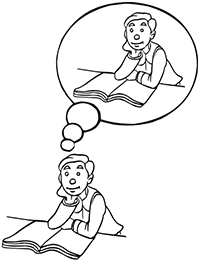In our first technology workshop we looked at how to make different types of animation and good ways of using and teaching these techniques in the classroom.
The first activity was making a flip book animation with a folded over piece of paper. The instruction was to start by drawing something on the inside of the paper. When the paper is folded over you should be able to see the image shining through, providing an ‘onion skin’ so that the next drawing can be drawn with only a slight alteration. This then allows the image to move when the paper is opened and shut at regular intervals. When doing this task with a class it is important to be prepared with folded pieces of paper for the pupils in the class, as they may not fold them exactly in half and the activity may not work as well. A clear demonstration will also be necessary to ensure that the pupils fully understand the task.
We then tried making another type of flip animation using the corner of our notepads; however post-it notes would be the best resource to use for this activity. The video below describes how this type of animation works.
Our third animation activity involved recreating a scene from the film ‘Frozen’ using the programme ‘Pivot Animator’. Like the previous activity this programme is designed so that you can make a scene using stick men and then make subtle changes to the picture using the ‘onion skin’ as a guide. This sequence of pictures makes the animation come to life. In the classroom you may choose to pick a story line or ask the children to recreate a specific scene from a film, as we did with the film ‘Frozen’. We learnt how to add different characters, how to change the colour of the characters and how to make our own characters. It may take a whole lesson to explain one of these skills to your class depending on their stage. It is also important to avoid teaching more than 3 new ICT skills in one lesson as it can be overwhelming for some pupils.
The above video is an example of an animation created using ‘Pivot Animator’. This is one of the very few videos on youtube, made using this programme, that does not involve any violence or inappropriate images. This is why it is important to be clear with your pupils that although others are using the programme in this way, it is a great classroom tool and similar inappropriate use will not be tolerated in the classroom setting.
For our third and final activity we worked in pairs and were shown how to use plasticine models to create an animation using the programme ‘Zu3D’. We learnt how to use cameras which plugged into the computer and that it was important to take five shots for each frame as it took an average of 25 scenes before the video was only a second long. We were also shown how to add in text at the start and end of the video and sound, if we wanted to include these aspects in our animations. Finally, we were shown how to save our animation in video format. A copy of our animation is available to download and view below.
Using animation in the classroom is not only a great way of teaching ICT skills but an opportunity to draw on other areas of the curriculum such as literacy, music and art. For example, the animation could be used as a stimulus for a story writing exercise. The children could also consider the use and impacts of the music used for animations and could even choose a piece of music as a stimulus for their animation. The plasticine models allow a link with art and the making of the actual animations requires team work and co-operation. It allows the pupils to be creative and to explore new ways of creating and developing ideas through the use of technology.

 wards such an important part of the curriculum.
wards such an important part of the curriculum.




